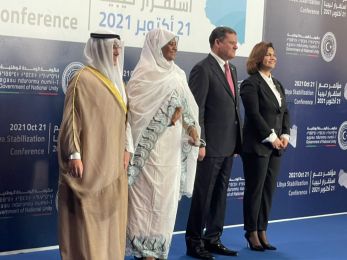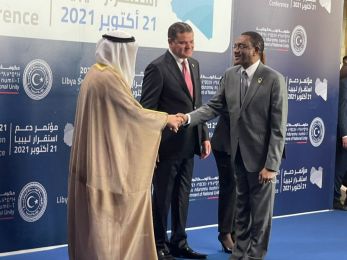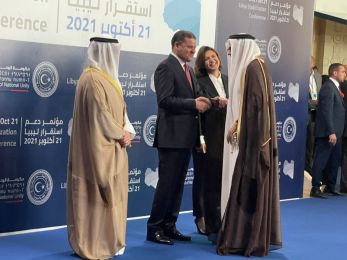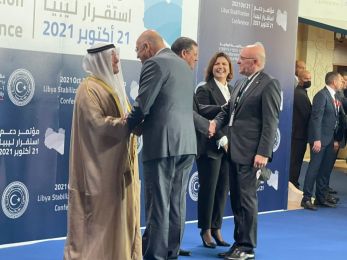PANAPRESS
Panafrican News Agency
Sudan: Sudan, Egypt, Ethiopia leaders sign pact on Renaissance Dam
Khartoum, Sudan (PANA) – Sudanese, Egyptian and Ethiopian leaders on Monday signed an agreement on the principles of the construction of the huge Ethiopian Renaissance dam.
Sudanese president Omar Bashir, Egyptian president Abdul Fattah Sisi and Ethiopian Prime Minister Haile Mariam Dessalgn signed the document at a ceremony held at the newly constructed republican Palace in Khartoum, declaring their commitment to work together and cooperate for the betterment of their people and the region at large.
Uganda, Rwanda and South Sudan sent high representatives to the ceremony.
In a statement before the signing ceremony, Prime Minister Dessalegn said Ethiopia was committed to fully cooperating with Egypt and the Sudan in all aspects related to the Nile water in the region.
He said the agreement will stress that the construction of the dam is "a win-win situation" for all the three countries, saying the project would not adversely affect any of the two countries or their people.
Sisi of Egypt said his country not only relied on the river Nile for its only source of water but that the "river Nile is the life of Egypt" and that therefore when this dam was about to start he made it clear that Ethiopians have the right to develop but have to take into consideration that Egypt's life depends on the Nile.
He said they have agreed to cooperate fully with the two other countries that the dam would not affect any of them and that it would be beneficial to the over 200 million people living in the three countries.
Bashir said by signing, the principle of how to work jointly on developing projects that would be beneficial to all and would harm no one, the three heads of state have taken the right step towards better cooperation in the region.
This is "a blessed step on the road for cementing cooperation among our people and boosting trust and mutual assistance in a way that would reflect positively on the stability, security and economic cooperation".
He stressed that this was the first time that African states would together alone and strike a deal without having to resort to foreigners to sort out their problems for them.
He described the agreement as "unprecedented and historic” in the relations between the three countries and the countries of the region.
“By signing this contract we have set the base that cooperation is the only means” for better the lives of the people of the three countries and the region.
The main purpose behind the construction of the dam is to generate electricity. It is designed to produce 6000 megawatt from 16 turbines, distributed between two stations. The dam ranks number eight worldwide with regard to its hydroelectricity generation. The first such dam is the Chinese three straits dam which produces 22,500 megawatts.
According to statistics released by the Dams Unit at the Ministry, the overall storage capacity of the Renaissance Dam is 74 billion cubic meters (of which 60 billion live storage). The lake covers an area of 1,800 meters and extends to 246 km, with the maximum highest of the dam reaching 145 meters. The dam produces 15,700 gigawatt/h annually.
By contrast, the Merowe dam storage capacity stands at 12 billion cubic meters, and the Egyptian High Dam storage capacity stands at 162 billion cubic meters, while the area covered by the lake created by Merowe dam stands at 800 square kilometers and the High dam covers 6,000 square kilometers.
The lake created by Merowe dam extends to 176 kms against 500 km for the High Dam Lake. The maximum highest for Merowe dam stands at 67 meter against 110 meters for the Egyptian High Dam. Merowe dam produced 5,600 Gigawatt/h annually against 10,000 Gigwatt/h annually for the High Dam. (Gigawatt equals one million kilowatts).
The dam is expected to produce clean electricity energy, three times the energy produced by all the present Sudanese electricity power stations. This will give a huge push to the development process in the three states and therefore help create social, political and security stability in the three nations.
-0- PANA MO/VAO 23March2015
Sudanese president Omar Bashir, Egyptian president Abdul Fattah Sisi and Ethiopian Prime Minister Haile Mariam Dessalgn signed the document at a ceremony held at the newly constructed republican Palace in Khartoum, declaring their commitment to work together and cooperate for the betterment of their people and the region at large.
Uganda, Rwanda and South Sudan sent high representatives to the ceremony.
In a statement before the signing ceremony, Prime Minister Dessalegn said Ethiopia was committed to fully cooperating with Egypt and the Sudan in all aspects related to the Nile water in the region.
He said the agreement will stress that the construction of the dam is "a win-win situation" for all the three countries, saying the project would not adversely affect any of the two countries or their people.
Sisi of Egypt said his country not only relied on the river Nile for its only source of water but that the "river Nile is the life of Egypt" and that therefore when this dam was about to start he made it clear that Ethiopians have the right to develop but have to take into consideration that Egypt's life depends on the Nile.
He said they have agreed to cooperate fully with the two other countries that the dam would not affect any of them and that it would be beneficial to the over 200 million people living in the three countries.
Bashir said by signing, the principle of how to work jointly on developing projects that would be beneficial to all and would harm no one, the three heads of state have taken the right step towards better cooperation in the region.
This is "a blessed step on the road for cementing cooperation among our people and boosting trust and mutual assistance in a way that would reflect positively on the stability, security and economic cooperation".
He stressed that this was the first time that African states would together alone and strike a deal without having to resort to foreigners to sort out their problems for them.
He described the agreement as "unprecedented and historic” in the relations between the three countries and the countries of the region.
“By signing this contract we have set the base that cooperation is the only means” for better the lives of the people of the three countries and the region.
The main purpose behind the construction of the dam is to generate electricity. It is designed to produce 6000 megawatt from 16 turbines, distributed between two stations. The dam ranks number eight worldwide with regard to its hydroelectricity generation. The first such dam is the Chinese three straits dam which produces 22,500 megawatts.
According to statistics released by the Dams Unit at the Ministry, the overall storage capacity of the Renaissance Dam is 74 billion cubic meters (of which 60 billion live storage). The lake covers an area of 1,800 meters and extends to 246 km, with the maximum highest of the dam reaching 145 meters. The dam produces 15,700 gigawatt/h annually.
By contrast, the Merowe dam storage capacity stands at 12 billion cubic meters, and the Egyptian High Dam storage capacity stands at 162 billion cubic meters, while the area covered by the lake created by Merowe dam stands at 800 square kilometers and the High dam covers 6,000 square kilometers.
The lake created by Merowe dam extends to 176 kms against 500 km for the High Dam Lake. The maximum highest for Merowe dam stands at 67 meter against 110 meters for the Egyptian High Dam. Merowe dam produced 5,600 Gigawatt/h annually against 10,000 Gigwatt/h annually for the High Dam. (Gigawatt equals one million kilowatts).
The dam is expected to produce clean electricity energy, three times the energy produced by all the present Sudanese electricity power stations. This will give a huge push to the development process in the three states and therefore help create social, political and security stability in the three nations.
-0- PANA MO/VAO 23March2015






